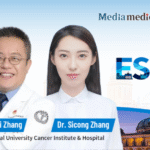
Editor’s Note: The 2025 European Society for Medical Oncology (ESMO) Annual Congress was grandly held in Berlin, marking another wave of major scientific breakthroughs in oncology. In the field of hematology, the spotlight shone on several cutting-edge research topics: from in-depth exploration of the mechanisms underlying CAR-T resistance — seeking new ways to overcome therapeutic challenges — to the development of innovative dual-target therapies that promise higher precision and efficacy; from precision discontinuation strategies in multiple myeloma that aim to prolong survival and improve quality of life, to single-cell mapping studies that provide new insights into the pathogenesis of hematologic malignancies. Each of these studies embodies the continuous innovation and progress in medical science and offers new hope for improving the diagnosis and treatment of blood diseases.To better focus on these hematologic breakthroughs and facilitate academic exchange, Oncology Frontier – Hematology News invited Dr. Cong Sun, from the research team of Professor Huilai Zhang at Tianjin Medical University Cancer Institute and Hospital, to share professional insights on the innovative aspects and clinical implications of one such study, as well as to discuss future trends in the field — providing valuable perspectives for both researchers and clinicians.
1247MO: Molecular Landscapes Across Histological Grades of Follicular Lymphoma — Insights from Genomic and Transcriptomic Analyses
Q1
Multivariate analysis in this study showed that FL3B, ECOG 3–4, and elevated serum LDH were independent risk factors for PFS, while only FL3B independently affected OS. According to survival curve data, FL3B patients receiving R-CHOP therapy had a significantly lower 5-year OS rate than those with FL1-2/FL3A. How do you view the role of these clinical indicators in guiding personalized treatment?
Dr. Cong Sun:
First, the Eastern Cooperative Oncology Group (ECOG) performance status and lactate dehydrogenase (LDH) level are widely used clinical risk indicators. The former reflects a patient’s functional condition, while the latter correlates with tumor burden. Both can help predict short-term disease progression risk to some extent. However, these indicators alone are insufficient to independently determine ultimate outcomes, which explains why they are not independent prognostic factors for overall survival (OS).
A key finding of this study is that Grade 3B follicular lymphoma (FL3B) is the only independent risk factor that simultaneously impacts both progression-free survival (PFS) and OS. This suggests that FL3B is not merely a pathological classification but represents a biologically distinct and highly aggressive lymphoma entity. Therefore, even if a patient has a good ECOG score and normal LDH levels, the presence of the FL3B subtype should warrant heightened clinical vigilance, as such patients may still face poor long-term prognoses.
Q2
Transcriptomic analysis revealed that with increasing histological grade, immune-related pathway activity decreased while metabolic pathway activity increased, alongside upregulation of MYC, IRF4, and BATF expression. How might these metabolic reprogramming features influence therapeutic optimization and patient outcomes?
Dr. Cong Sun:
Metabolic reprogramming and the formation of an immunosuppressive microenvironment are two sides of the same coin in driving tumor aggressiveness — they are interrelated processes that collectively promote disease progression.
For patients with Grade 3A follicular lymphoma (FL3A), if an immunosuppressive microenvironment is identified, incorporating immunomodulatory agents such as lenalidomide may help enhance therapeutic efficacy and improve prognosis. In contrast, for relapsed or refractory Grade 3B FL (FL3B) or mixed follicular and diffuse subtypes, combining standard therapy with drugs targeting tumor metabolism could represent a promising strategy to overcome poor outcomes.
That said, translating these molecular insights into clinical benefit remains a long journey — from fundamental research to real-world applications that truly improve patient survival.
Q3
Based on the overall study findings, how do you assess the significance of this research, and what future directions should be explored to advance the field?
Dr. Cong Sun:
This study sought to address a key scientific question: whether follicular lymphomas of different histological grades share the same molecular origins. This is crucial, as the future of lymphoma diagnostics will inevitably evolve from purely morphological assessment toward integrated morpho-molecular diagnosis.
Our results demonstrate that even morphologically similar lymphomas can exhibit marked molecular heterogeneity, which likely underpins the varied therapeutic responses and clinical outcomes observed among patients.
Our current work represents only the first step. Moving forward, we plan to deepen our research on tumor cell origins, the early progression and transformation mechanisms of follicular lymphoma, and the development of precise, individualized treatment strategies in clinical practice. Our center has already initiated a comprehensive research roadmap in these directions, and we hope that future studies will yield more groundbreaking results.
Dr. Cong Sun
Research Team of Professor Huilai Zhang
Tianjin Medical University Cancer Institute and Hospital


